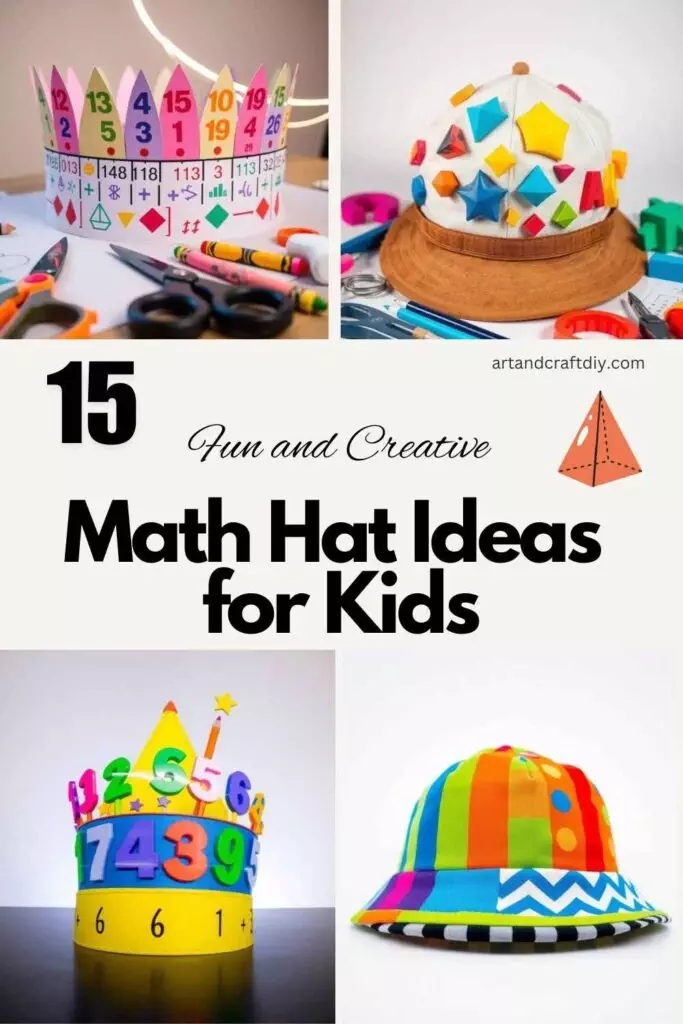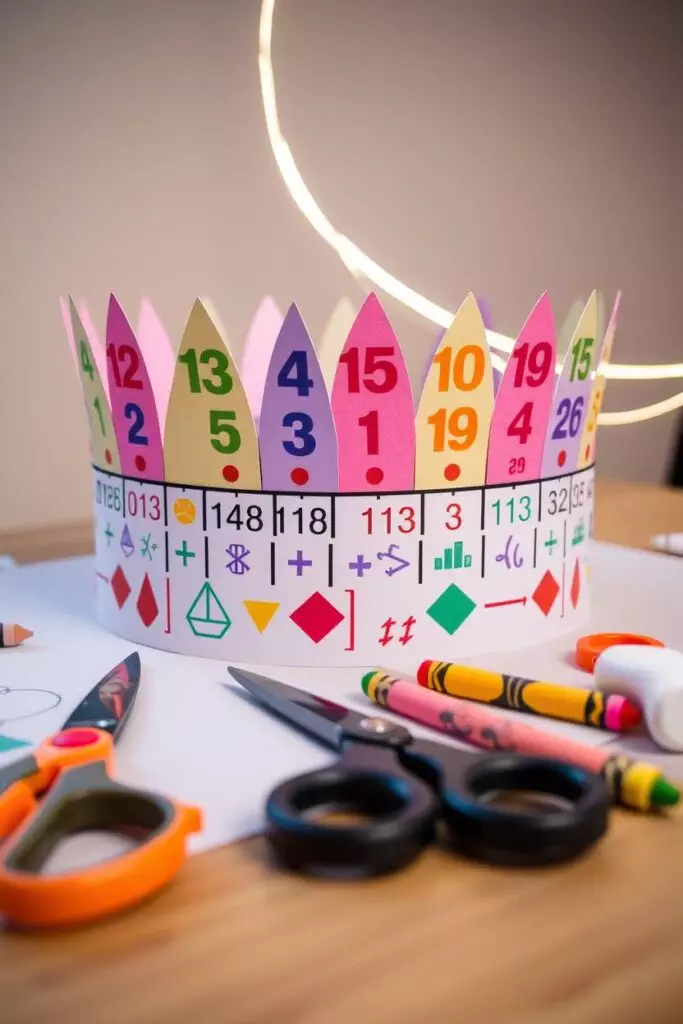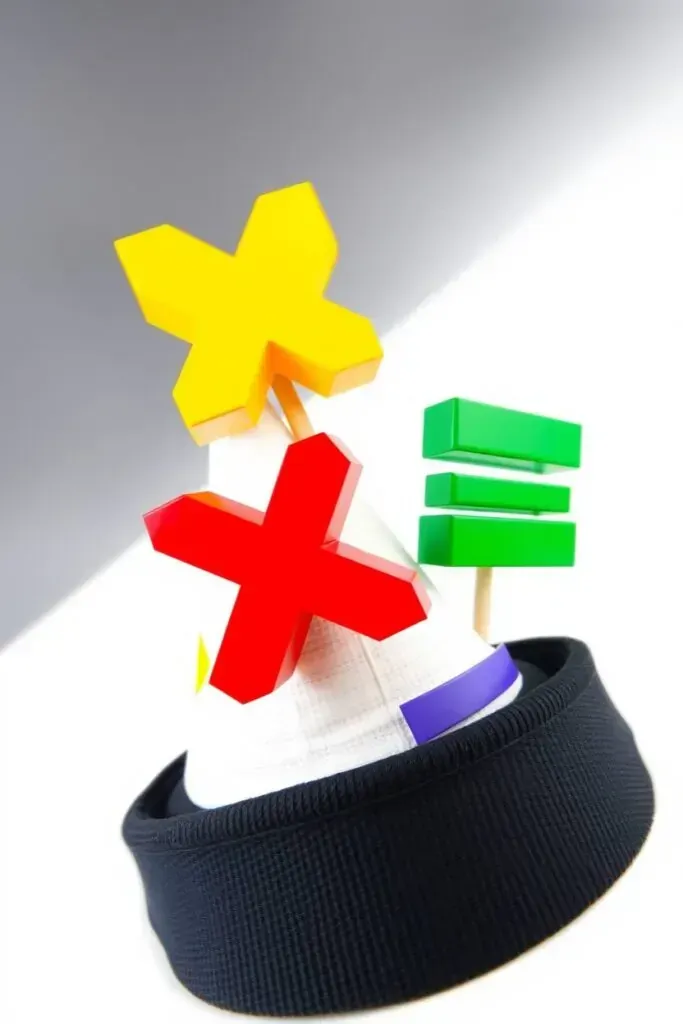Math Hat Ideas for Kids are a fun and creative way to make learning math exciting! A Math Hat is a wearable hat decorated with math-related themes such as numbers, shapes, symbols, or equations. Kids can design and create their own hats using colorful materials, bringing math concepts to life in a playful way.
These hats are a great tool to promote both creativity and math engagement. As children craft their hats, they also reinforce what they’ve learned in class—whether it’s counting, geometry, patterns, or even famous mathematicians.
Math Hat Ideas for Kids
Math Hat Ideas for Kids are fun, creative hats decorated with math themes like numbers, shapes, or equations. They make learning more exciting during Math Day, school events, or classroom activities.
Number Line Hat
A Number Line Hat is a fun way for kids to learn about counting, addition, and subtraction. It features a colorful line of numbers stretched across a hat or headband. This helps children visualize number order and simple math operations in a creative way. It’s great for younger kids who are just learning their numbers.
-
Use a long paper strip to create the number line from 1 to 10 or 1 to 20.
-
Mark every fifth or tenth number in a different color.
-
Add arrows or symbols to show addition or subtraction movement.
-
Let kids decorate with stickers, dots, or mini counters.
-
Encourage them to “solve” mini problems by pointing to the right number.
Shape Explorer Hat
This hat turns your child into a shape explorer! It features different 2D shapes like triangles, squares, and circles arranged around the hat. Kids get to recognize shapes and their properties while being creative. It’s perfect for preschoolers and early primary grades.
-
Cut out foam or paper shapes in bright colors.
-
Label each shape with its name and number of sides.
-
Add a magnifying glass or explorer badge for fun.
-
Use pipe cleaners to create 3D versions popping out from the top.
-
Include a matching activity where they find shapes in the room.
Times Table Topper
A Times Table Topper makes learning multiplication facts more fun! This hat displays multiplication tables in a colorful and organized way. Great for students in grades 2–5, it turns memorization into a wearable game.
-
Design a spinning wheel with multiplication facts on top.
-
Use a tall paper hat and decorate each side with a different times table.
-
Include a fold-down quiz panel for quick practice.
-
Add visual aids like groups of dots or objects.
-
Let kids wear it during math drills for confidence.
Pattern Parade Hat
Kids love patterns, and this hat celebrates repeating designs using colors, shapes, or numbers. The Pattern Parade Hat encourages visual thinking and helps build early algebra skills.
-
Use colored paper strips to make AB, ABB, or AAB patterns.
-
Glue foam stickers or beads in a repeated order.
-
Have a challenge to continue the pattern around the back.
-
Include a small flap that shows the rule of the pattern.
-
Turn it into a class parade and vote on the most creative pattern.
Geometry Genius Hat
This hat is perfect for learning about lines, angles, and geometric properties. Kids can build mini models of angles or shapes and attach them to the hat. It’s perfect for students learning more advanced geometry concepts.
-
Use straws to make angles (acute, right, obtuse) and glue them on.
-
Label parts of shapes like vertices and sides.
-
Add string or yarn to show parallel and intersecting lines.
-
Include a mini protractor attached to the side.
-
Have a pop quiz activity based on the hat’s features.
Fraction Fun Hat
The Fraction Fun Hat makes it easy to understand parts of a whole. Kids decorate their hats with pies, bars, or pizzas divided into fractions. It’s ideal for grades 3 and up.
-
Create circle cutouts showing halves, thirds, fourths, etc.
-
Use Velcro to make pieces removable and interactive.
-
Add real-life fraction examples (like ½ pizza or ¼ cake).
-
Color-code different fractions to make them stand out.
-
Attach a spinner to land on a random fraction to identify.
Math Symbol Hat
This hat is all about the cool symbols we see in math. It features plus, minus, multiplication, division, equal signs, and more. Kids learn the meaning of each symbol while having fun decorating their hats.
-
Cut out oversized foam or cardboard symbols.
-
Label each one with its name and use.
-
Add a tiny matching game with symbol flashcards.
-
Use glitter or foil to make the symbols shiny.
-
Make it 3D by placing symbols on springy pipe cleaners.
Measurement Master Hat
This idea turns your child into a measurement expert! The hat shows rulers, clocks, thermometers, and measuring cups. It’s great for teaching units of length, time, and weight.
-
Attach a paper ruler strip around the base.
-
Add a working clock face on the front.
-
Create mini measuring cups labeled with milliliters and ounces.
-
Draw a thermometer that shows temperature in Celsius and Fahrenheit.
-
Include labels for “inch,” “cm,” “grams,” “liters,” etc.
Math Word Problem Hat
The Word Problem Hat is an interactive way to build thinking and reasoning skills. It features mini problem cards attached around the hat that classmates can solve. This is great for collaborative learning.
-
Write short word problems on flaps or cards around the hat.
-
Use Velcro so problems can be changed daily.
-
Decorate with symbols related to the story (coins, apples, etc.).
-
Leave space for kids to write their own problems.
-
Encourage kids to walk around and solve each other’s hat problems.
Pi Day Celebration Hat
Perfect for March 14, the Pi Day Hat is full of fun facts about π! It’s ideal for older students who are learning about circles and circumference.
-
Add the digits of Pi wrapped around the entire hat.
-
Create a large π symbol on the top.
-
Include formulas like C = 2πr and A = πr².
-
Use images of pies to make it more playful.
-
Add trivia facts about Pi and its history.
Money Math Hat
This hat helps kids learn to count coins and understand money value. Decorated with real or pretend coins, it’s both visual and practical.
-
Glue printed coins and bills around the hat.
-
Create coin-matching flaps for practice.
-
Include a mini “store” on the hat for pretend shopping.
-
Use play money to show change-making examples.
-
Label each coin with its value and color-code by size.
Symmetry Hat
This cool hat teaches kids about symmetry by using mirrored designs. It helps develop spatial understanding and artistic creativity.
-
Fold paper in half and design symmetrical shapes.
-
Use a mirror to check symmetry in the design.
-
Decorate one half, then replicate it on the other side.
-
Label the line of symmetry clearly.
-
Make it a game—can a partner find the mismatch?
Math Monster Hat
Make math silly and spooky with a monster-themed hat! It includes math questions coming out of a monster’s mouth or crazy eyes. This hat turns fear of math into laughter.
-
Design a big googly-eyed monster face.
-
Cut out “question tongues” with math problems on them.
-
Add number teeth and equation eyebrows.
-
Use silly colors, fur, or yarn for fun texture.
-
Let the monster “eat” wrong answers with a flap pocket.
Famous Mathematician Hat
Teach kids about history by highlighting famous math figures. Each hat honors a different mathematician and their achievements. It’s perfect for research-based projects.
-
Print a small portrait of the mathematician for the front.
-
Add a timeline or brief bio around the crown.
-
Decorate with symbols or tools related to their work.
-
Include a famous quote or formula.
-
Let students present their hat to the class.
Group or Class Activity Tips
Creating Math Hats as a group or class activity is a fun and engaging way to combine creativity with learning. It encourages students to explore math concepts in a hands-on manner while also boosting their confidence through presentation and collaboration. Whether it’s part of Math Day, a STEM event, or a classroom project, these activities turn learning into a celebration.
-
Assign each student a math topic such as fractions, shapes, equations, or famous mathematicians. This ensures variety and helps cover multiple areas of the math curriculum.
-
Host a “Math Hat Parade” where students walk around wearing their hats, showing off their creativity to classmates, teachers, or even parents.
-
Let each student explain their hat—what they made, what it represents, and what math concept it shows. This builds speaking skills and reinforces understanding.
-
Award simple certificates or titles like “Most Colorful Hat,” “Best Shapes Hat,” or “Most Creative Math Concept” to celebrate everyone’s effort and make the event special.
-
Create a display area in the classroom or hallway where hats can be showcased for a few days, helping reinforce learning and inspire others.
FAQ
What are Math Hat Ideas for Kids?
Math Hat Ideas for Kids are creative, wearable hats decorated with fun math themes like numbers, shapes, equations, and patterns. They help children engage with math concepts in a hands-on and imaginative way.
What age group are Math Hats suitable for?
Math Hats can be adapted for all age groups—from preschoolers learning basic shapes to older kids exploring fractions, geometry, or multiplication tables. The difficulty and design can match the child’s learning level.
What materials are needed to make a math hat?
Basic materials include construction paper, glue, scissors, markers, stickers, foam shapes, and tape. Optional items like pipe cleaners, Velcro, glitter, and googly eyes can add extra fun and creativity.
Can math hats be used in the classroom?
Yes! Math hats are great for classroom activities, Math Day celebrations, or as part of a math project. Teachers can assign topics, host a hat parade, or let students explain their hat to reinforce learning.

Hi, I’m Victoria, an art and craft teacher at Newark City Schools, where I have the joy of working with middle school students to help them explore their creativity and develop their artistic talents. I believe that art is a powerful way for students to express themselves, and I strive to make every lesson a fun, engaging, and inspiring experience.
I created this website to share the art and craft projects, techniques, and resources that I use in my classroom, hoping to inspire both educators and young artists alike. Whether you’re a teacher looking for new ideas or a student eager to try something new, I’m excited to provide creative tools and projects that anyone can enjoy.
When I’m not in the classroom, I love experimenting with different art forms and learning new crafting techniques. My goal is to help others discover the joy of making things with their hands, and I hope my website serves as a space for everyone to explore their creative potential.










